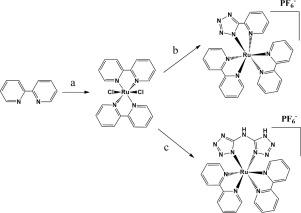Journal of Inorganic Biochemistry ( IF 3.8 ) Pub Date : 2020-06-01 , DOI: 10.1016/j.jinorgbio.2020.111127 Jie Yang 1 , Xin He 2 , Zhen Ke 3 , Jianjiao Chen 3 , Zhenyuan Zou 3 , Bo Wei 4 , Dengfeng Zou 3 , Jianhua Zou 4

|
Ru (II) compounds have potential application in photodynamic therapy (PDT). In the current study, two Ru (II) compounds based on the auxiliary ligand 2,2′-bipyridine (bipy) by changing main ligands 5-(2-pyridyl) tetrazole (Hpytz) and di(2H-tetrazol-5-yl) amine (H2datz) have been successfully synthesized and characterized, [Ru (pytz)(bipy)2][PF6] (1) and [Ru(Hdatz)(bipy)2][PF6] (2). These compounds can form nanoparticles (NPs) by nano-precipitation. And [Ru(pytz)(bipy)2][PF6] NPs with a lower half maximal inhibitory concentration (IC50) of 37 μg/mL on HeLa cells than that of [Ru(Hdatz)(bipy)2][PF6] NPs (65 μg/mL). Meanwhile, negligible dark toxicity has been also observed for these NPs even under high concentrations. The results show that [Ru(pytz)(bipy)2][PF6] (1) and [Ru(Hdatz)(bipy)2][PF6] (2) NPs can inhibit cell proliferation in vitro, and may be potential candidates for photodynamic therapy.
中文翻译:

基于四唑配体的两种光敏Ru(II)化合物,用于光动力治疗。
钌(II)化合物在光动力疗法(PDT)中具有潜在的应用。在当前的研究中,通过改变主要配体5-(2-吡啶基)四唑(Hpytz)和二(2H-四唑-5-基),基于辅助配体2,2'-联吡啶(bipy)的两种Ru(II)化合物)胺(H 2 datz)已成功合成和表征,[Ru(pytz)(bipy)2 ] [PF 6 ](1)和[Ru(Hdatz)(bipy)2 ] [PF 6 ](2)。这些化合物可以通过纳米沉淀形成纳米颗粒(NPs)。并且[Ru(pytz)(bipy)2 ] [PF 6 ] NPs的半数最大抑制浓度较低(IC 50)在HeLa细胞上比[Ru(Hdatz)(bipy)2 ] [PF 6 ] NPs(65μg/ mL)高37μg / mL。同时,即使在高浓度下,对于这些NP也观察到了可忽略的黑暗毒性。结果表明,[Ru(pytz)(bipy)2 ] [PF 6 ](1)和[Ru(Hdatz)(bipy)2 ] [PF 6 ](2)NPs在体外可以抑制细胞增殖,可能是光动力疗法的潜在候选人。









































 京公网安备 11010802027423号
京公网安备 11010802027423号